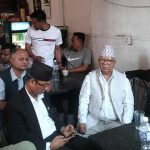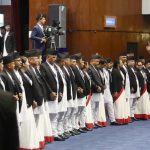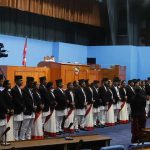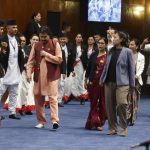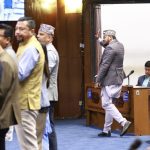Kathmandu: 72 years old Khilnath Nepal was inside Narayanhiti Palace on 1st June 2001 A.D. (19th Jestha, 2058 B.S.). Khilnath has been residing in Mahankal, Kathmandu.
Khilnath was the head of the cowshed inside the Palace. Technically, he was in the position of ‘Naike’ (leader) of the cowshed.
At that time, 26 out of total 55 cows were in the palace. A total of 21 employees were in the service for taking care of the cows, milking them, as well as preparing curd and milkshake for the then King Birendra Shah’s resident ‘Shree Sadan’ and his mother Ratna’s ‘Kuti.’ The duty of Khilnath was to assign duties to 21 employees.
Khilnath, like always had sent his assistant to deliver 4 Manas (approximately 0.568 liters) of milk to Shree Sadan, where King Birendra, Queen Aishwarya, their sons Dipendra and Nirajan used to reside. The assistant used to deliver the milk and came back with the milk utensil before 6 o’clock in the morning. But, that day, when Khilnath saw his employee returning empty hands, he got goosebumps.
There was a feast in the palace, the previous night, on Jestha 19 (June 1). Khilnath had also heard the sounds of gunshots on the night. But, Khilnath and his assistants did not pay much attention to the sound as armies inside the palace used to fire guns time and again.
However, the rumors of some terrible incidents in the palace had started to spread. The waiters, who had carried glasses to the feast, who poured expensive alcohol into the glasses, and the chefs said that Dipendra did some unpleasant incident, which resulted in the injury of some royal members, and the injured ones were taken to the hospital. There was no point in agreeing or disagreeing about the rumors of such incidents occurring in the palace. That’s why, Khilnath didn’t think about it more.

It was in the morning that the tables suddenly turned. As usual, Babukaji Shrestha (from Naikap), came into the palace. He started doing Puja and playing the bells in the temple, which was at the front gate of the palace. Another assistant came and said, ‘Why are you playing bell? Everyone is saying Sarkarharu (his majesties) died. Didn’t you know about it?’ This gave shivers to Khilnath.
Those words hit the ears of Khilnath like a thunderstorm. The earth started drowning. He was immediately on the floor. It was only a day before that King Birendra talked with Khilnath with a smiley gesture. Khilnath was not only dear to King Birendra but was also to Queen Aishwarya, their sons Dipendra and Nirajan as well as daughter Shruti.
Khilnath had been taking responsibility for taking care of the cows, milk, preparing curd, and milkshake since 2034 B.S. (1977 A.D.). It was printed in Khilnath’s mind about how royal members drink and up to what quantity.
Birendra didn’t use to drink milk. He only used to have curd and milkshake. Khilnath shared his experience of Aishwarya’s nature of only drinking the milk if it was immediately served after just one boil. But Dipendra and Nirajan used to love the thick milk that was boiled for a longer period of time.
He said, ‘I don’t remember Birendra paying attention to milk. But I remember Aishwarya used to drink 1 mana of boiled milk and mother Ratna Rajya Laxmi used to often drink the thick milk that was reduced from 3 to 1 mana by continuous boiling. Both their sons Dipendra and Nirajan used to love thick milk as they were involved in sports and exercise.’
According to Khilnath, a total of 45-60 liters of milk used to be milked every day from the cows inside the palace. Out of the total quantity, 4 manas used to be delivered to Shree Sadan early in the morning, 3 manas to Ratna’s Kuti, and the rest used to be taken to the ‘Putali Dhoka.’ It was from the ‘Putali Dhoka’ that curd was prepared. Also, from there, the rest of the remaining milk was distributed to other Royal relatives, Army generals, priests of the palace, and others.
That day, Jestha 20 (June 2), it was not just from the Shree Sadan but it was also from Ratna’s kuti that the utensil didn’t return.
Khilnath added, ‘The words spread like wildfire in the forest that every member of the Royal family was dead. We were informed that they were sick in the night but no one survived in the morning. The rumors were spread to a great extent. It was even heard that mother Ratna had engulfed Diamond after knowing about the death of his son, daughter-in-law, and grandchildren. But I didn’t believe that because I had seen her with my eyes. I was restless so I went to the house. ‘
A lot of things started to move in Khilnath’s mind after the Royal Massacre. He was not able to sleep for many nights.
Before the Royal Massacre, Khilnath was aware of the increasing conflict between Dipendra and his mother Aishwarya. Mother Aishwarya and Sister Shruti were aware of the closeness of Dipendra within the related ones, another girl, a love affair with a foreigner, and many more. Dipendra warned to kill everyone and himself when the conflict started reaching its peak. But, Khilnath does not feel like Royal Massacre was a result of that conflict. Khilnath has been searching for the answer to the question that if Dipendra had annihilated his kin, who shot a bullet at Dipendra?
Khilnath had not debated with anyone regarding good or bad as he thought that it was better to remain silent regarding the internal affairs of the palace. One question has been haunting Khilnath continuously. – ‘How can I believe that it was Crown Prince Dipendra who killed gentle and graceful King Birendra?’
Khilnath remembers another incident. Just 15 days ahead of the royal massacre, about 17 milking cows had died. It was assumed that the cows died of infection. But Khilnath said,’ That was not true.’

After some days, Nirajan’s horse died. The day after that day, Shruti’s horse died. The series of incidents was not a good omen. It triggered Khilnath to feel that something great evil incident was approaching. And that’s what happened. The Royal Massacre.
King Birendra’s horse died after three days of the Royal Massacre. Even the dogs of Birendra and Aishwarya died after a few days of the incident. It was not just his loving King Birendra who passed away but the animals who used to love him were also leaving Khilnath. This started to turn the atmosphere of the palace more gloomy. This triggered Khilnath to leave his job in Palace in Chaitra, in 2058 B.S.(2001 A.D.).
Khilnath is the same worker, who had walked for 4 days to reach Kathmandu from Okhaldhunga. He never served King Gyanendra and his son Paras, who came into power after the royal massacre. Khilnath even broke the trend of offering dam (coin) on the feet of the King, on the occasion of their birthdays or festivals.
Khilnath had shaved his head while he was on his way to Kathmandu from Okhaldhunga when he came to know that King Mahendra had died. He had reached Ratmata of JhangaJholi, Sindhuli. The locals halted his journey and questioned ‘Why haven’t you shaved your head in the death of King?’ And had shaved his head.
Khilnath had not only walked from Okhaldhunga to Kathmandu but had walked from Mahankal to Narayanhiti and vice versa every day, during his service period in the palace from 2034 to 2058 B.S. (1977-2001 A.D.).
(Photo Credit: Saroj Basnet)
[Translated by Essence Shrestha]
The Nepali version of the story was published in the early morning today.





